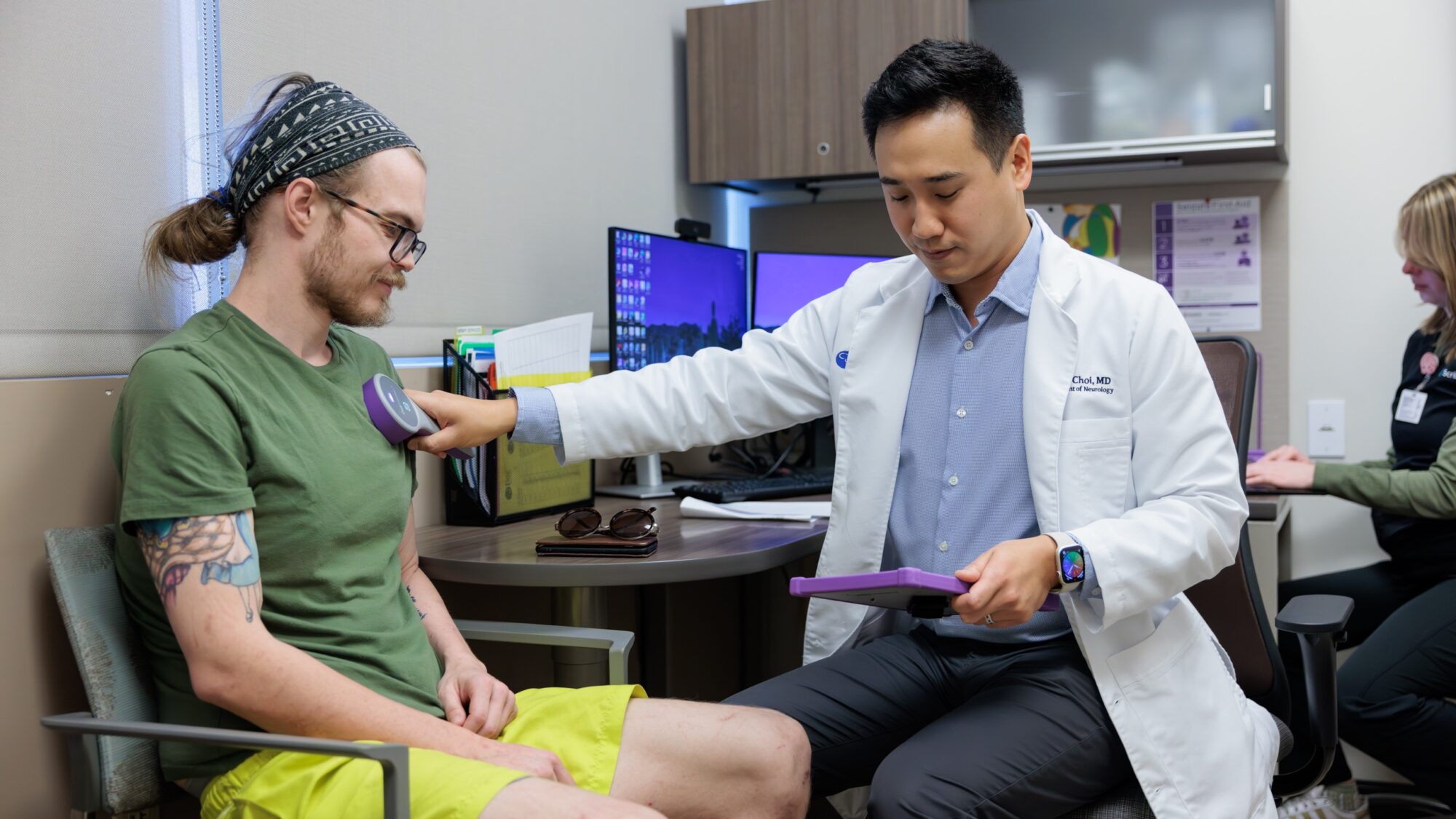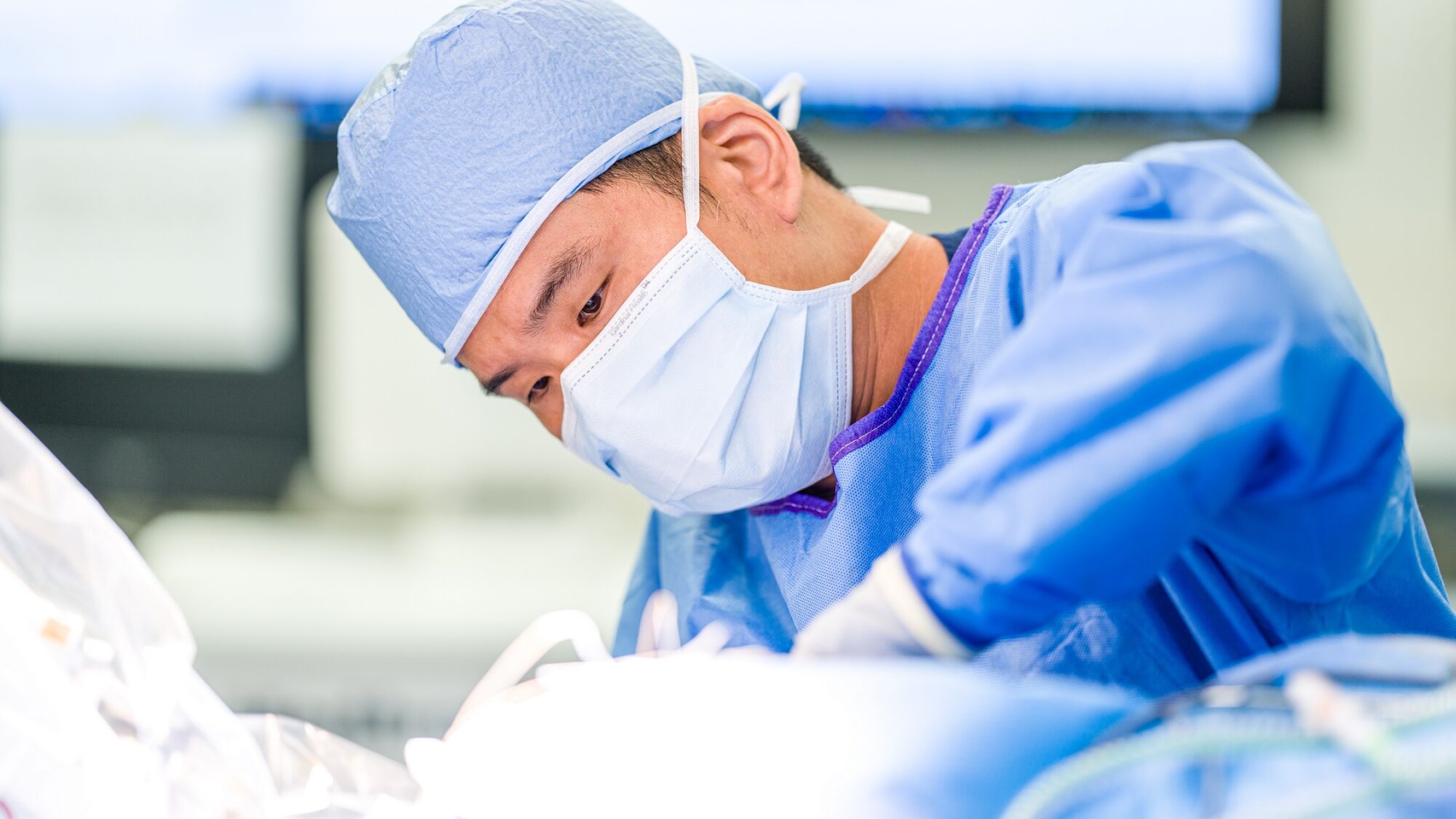
Vagus Nerve Stimulation (VNS)
Vagus Nerve Stimulation (VNS) Overview
Vagus nerve stimulation (VNS) is a type of therapy used to treat certain neurological conditions, including:
- Epilepsy
- Refractory depression
- Ischemic stroke (to augment arm and hand rehabilitation)
VNS treatment is a minimally invasive surgery involving implanting a pacemaker-like device that sends small pulses of electrical energy to the vagus nerve (the tenth cranial nerve, or cranial nerve X). This major nerve runs from the brain, through the neck, and into the body.
The vagus nerve is part of the parasympathetic nervous system, which regulates multiple bodily functions, including breathing, heart rate, digestion, and mood. It is the longest of the 12 cranial nerves (nerves that originate directly from the brain instead of the spinal cord), which send information from the brain to other parts of the body and, just as importantly, carry information back to the brain. By delivering periodic stimulation directly to the vagus nerve, VNS therapy helps modulate brain activity.
In epilepsy, this reduces the number, severity, and duration of seizures a person experiences.
In depression, stimulation leads to improvement in depressive symptoms. VNS is especially compelling as a treatment for epilepsy because people with epilepsy are several times more likely to develop mental health problems, including depression. For these two disorders, the device delivers stimulation around the clock, following a duty cycle (on for 30 seconds, off for 5 minutes or less).
VNS can augment motor function following a stroke using equipment made by a different medical device company using a different mode of stimulation paired with movements made during rehabilitation therapy and daily activities.
Similar to a cardiac pacemaker, the VNS device comprises two connected components that a surgeon places underneath the skin:
- The implantable pulse generator: This implantable device is smaller than or similar in size to a pacemaker (approximately 5 cm by 5 cm and less than 1 cm thick). It houses the circuitry and battery, generating electrical pulses for the vagus nerve. The pulse generator is placed under the skin in the chest area, just below the collarbone, where it connects to the lead wire.
- The lead wire: The lead wire is a thin, insulated wire that carries electrical pulses from the pulse generator to the vagus nerve. It is connected to the pulse generator at one end and routed to the left vagus nerve, which travels down from the brain deep within the neck. The wire terminates in metal contacts, arranged like spirals that wind around the vagus nerve.

What does vagus nerve stimulation (VNS) help treat?
VNS therapy is a treatment for people with drug-resistant epilepsy or whose seizures haven’t responded adequately to at least two different anti-seizure medications. It is used as an adjunctive treatment, meaning it’s used in conjunction with other epilepsy treatments, such as medications or diet regimens (for example, the ketogenic diet). VNS may allow you to reduce the amount of medications you take without loss of seizure control.
Additionally, the FDA has approved VNS for depression, as well as to augment motor rehabilitation following ischemic stroke. Researchers are investigating VNS as a potential therapy for many other conditions, such as hemorrhagic stroke, migraine, and rheumatoid arthritis. Researchers have hypothesized that VNS influences the release of neurotransmitters like serotonin and norepinephrine in the brain, which regulate mood, arousal, and seizure threshold, among other aspects of brain activity.
While VNS treatment rarely leads to complete seizure freedom, it offers the potential for significant relief from epilepsy. By reducing seizure frequency and severity, VNS can boost your ability to participate in everyday activities and improve your quality of life.
VNS Procedure
Before treatment can begin, a team of neurologists, neurosurgeons, and other specialists will evaluate you to determine whether you’re a good candidate.
Once approved, the process typically involves the following steps:
- Surgical Implant. The procedure is done under general anesthesia and typically takes one to two hours. It requires two small horizontal skin openings (incisions). The first is in the left upper chest area, just below the collarbone, to accommodate the implantable pulse generator.The second incision is on the left side along a natural crease of the neck. The left vagus nerve is exposed deep within the neck, and the stimulating end of a thin lead is wrapped around the nerve. Once securely positioned around the vagus nerve, the neurosurgeon connects the lead to the pulse generator, and the surgical team tests the system in the operating room to confirm functionality.
- Postoperative recovery: Surgery is typically done in an outpatient setting, with patients being discharged home on the day of surgery once awake from anesthesia. Although the device is turned on during the surgery, it is set to a low level of stimulation that is usually not therapeutic (subtherapeutic).
- Follow-up care: Most people can resume normal activities within a few weeks after surgery. In addition to follow-up appointments with your neurosurgeon, you will have appointments with your neurologist to reach a therapeutic stimulation level and adjust the device settings as needed. This process of fine-tuning the device settings for individual patients is called device programming.

VNS Programming and Use
VNS devices require careful programming to optimize their effects. Your neurologist will adjust stimulation intensity in small increments, so the initial programming to reach a therapeutic stimulation level can take a few weeks to months.
After the initial programming, you’ll continue regular follow-up appointments with your neurologist to monitor your response to VNS therapy.
VNS devices have a magnet activation feature that allows you to manually trigger an extra dose of stimulation by waving a small magnet over the pulse generator in the chest. You can do this if you feel a seizure is about to come on (aura) or after a seizure has started. Studies show that magnet activation can make seizures less severe and even abort seizures in some cases.
In addition, the majority of seizures are associated with abrupt increases in heart rate immediately prior to seizure onset. Some newer VNS devices take advantage of this signal by supplementing the usual programmed stimulation in response to sudden increases in heart rate.
While people are generally unaware of vagus nerve stimulation, some may experience temporary sensory changes (like tingling in their throat or neck), a hoarse or weak voice, or a mild cough when stimulation occurs. These adverse effects of stimulation improve with time in most of these people and are rarely debilitating. Your neurologist can make additional changes to the device to mitigate these side effects or turn it off completely. In rare cases, the device can be surgically removed, for example, if there is a device infection.
Common Questions about Vagus Nerve Stimulation (VNS)
Who is a good candidate for vagus nerve stimulation (VNS)?
You may be a good candidate for VNS if you have epilepsy that is not adequately controlled with at least two different anti-seizure medications (age four and older).
For depression, you may be eligible if your symptoms have not had an adequate response to four or more antidepressant medications (age 18 and older).
For motor rehabilitation of the upper extremities following a stroke, you may be eligible for VNS depending on the nature of the stroke, how long ago the stroke occurred, and current motor function (age 22 and older).
Patients are generally referred for neurosurgical consultation by healthcare providers in the corresponding medical specialties:
- Neurology (epilepsy)
- Psychiatry (depression)
- Physical Medicine and Rehabilitation (stroke rehabilitation)
- Occupational therapy (stroke rehabilitation)
Is VNS safe?
The U.S. Food and Drug Administration (FDA) approved VNS in 1997 for epilepsy, in 2005 for depression, and in 2021 for stroke rehabilitation.
While VNS is a surgical treatment, and all surgeries have risks, the risks associated with the therapy are relatively low. They can include bleeding or infection at the site of placement, a small risk of damage to nearby structures (blood vessels, esophagus, or windpipe), device complications such as infection, and generally temporary symptoms related to the vagus nerve (hoarseness, coughing, shortness of breath).
What kind of results can I expect?
Most people who have undergone VNS treatment report a higher quality of life. Clinical studies have shown that VNS therapy can significantly reduce seizure frequency over time, as well as seizure duration, severity, and recovery time.
Studies have shown that after the first three months of use, seizures can decrease by about 40 percent. Additionally, VNS treatment generally improves over time—after one to two years of therapy, 50 percent of people experience at least a 50 percent decrease in seizure activity.
For depression, studies suggest that VNS as an adjunct to standard of care therapy (which includes medications) may increase treatment response as well as remission rates by up to two to four times compared to standard of care alone.
For stroke rehabilitation, studies show that VNS paired with in-clinic occupational therapy can increase the chances of achieving a meaningful improvement in arm and hand function by double that of occupational therapy alone. Following in-clinic rehabilitation, you can expect to use the device by self-administering stimulation paired with home exercise programs. Studies suggest that the degree of improvement and the percentage of people achieving meaningful improvement may increase with such longer-term use.
What is the difference between vagus nerve stimulation (VNS), responsive nerve stimulation (RNS), and deep brain stimulation (DBS)?
There are three devices used in the treatment of epilepsy. Each is implanted in different parts of the nervous system and provides electrical stimulation in device-specific ways.
Vagus nerve stimulation (VNS) does not directly stimulate the brain. Instead, neurosurgeons implant a pulse generator under the skin in the chest wall and connect it to a wire that wraps around the vagus nerve deep within the neck. The device sends pulses of electrical activity at rhythmic intervals to the brain via the vagus nerve.
In deep brain stimulation (DBS), electrodes are implanted in deep structures of the brain. It typically uses two wires, one for each side of the brain. DBS electrodes are connected to a neurostimulator placed under the skin of the chest, beneath the collarbone (as for VNS), and provide electrical pulses directly to the brain continuously or at rhythmic intervals.
While other devices provide stimulation continuously or at rhythmic intervals, responsive neurostimulation (RNS) does so in response to abnormal electrical activity detected in the brain via the implanted electrodes and neurostimulator. The neurostimulator is embedded within the skull, above the covering of the brain, so the device is not noticeable through the scalp.
Information and Resources about Vagus Nerve Stimulation (VNS)
Epilepsy Foundation – VNS Therapy



